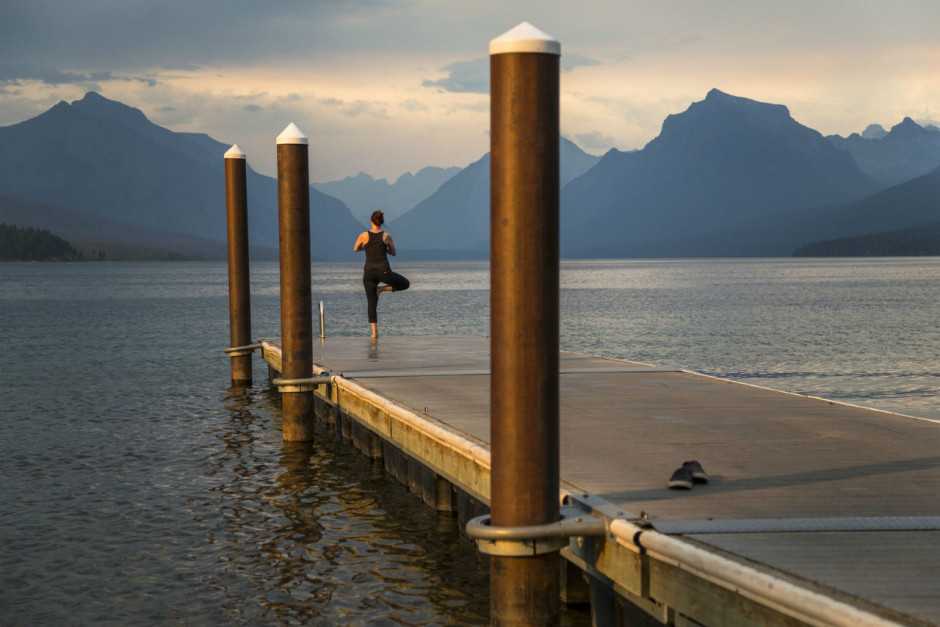
You might also like:
ENCOMPASSING A MILLION ACRES of mountains, lakes, rivers, and epic landscapes carved by gigantic ice flows 20,000 years ago, and its famous baked goods. While there are accommodations at the Swiss-style lodges, motor inns, and campgrounds within Glacier, there are no populated town sites. Instead, buzzing communities minutes from the park’s boundary, like between Waterton Lakes National Park, just over the border in Canada, and Glacier National Park is being initiated so that they can become a designated International Dark Sky Park/Preserve.
14
Sunset over the park
Typically the Going-to-the-Sun Road opens in its entirety in mid-to-late June, which means Glacier National Park’s most famous road is a prime biking and hiking destination throughout spring and and in advance. 
19
At Lake McDonald
Glacier is home to 762 lakes. The longest (9.4 miles), largest (6,823 acres), and deepest (464 feet) is Lake McDonald.
Glacier is also one of the few parks in the country where you don’t need a car to get to or around the park. Amtrak trains stop at East Glacier Park, West Glacier, and Essex. From there, you can take tours through the main parts of the park in Red Jammers; they’re restored 1930s coaches that run on propane to lessen their environmental impact.

20
Moose
Glacier’s “big three” comprise some of the most impressive mammals in North America: mountain goats, moose, and grizzly bears. Over the border in Waterton Lakes National Park—a joint International Peace Park with Glacier—you’re more likely to see bighorn sheep, elk, and black bears. 
21
McDonald Creek in winter
On a winter trip to Glacier, bring your binoculars. Elk, moose, and mule and white-tailed deer are all much easier to spot against a snowy backdrop, and they typically winter at lower elevations. White-tailed ptarmigans and harlequin ducks stay at the park during the colder months, too. 
22
Boating Lake McDonald
In honor of the 2016 centennial of the National Park Service, many companies and park concessioners are offering specialty tours. You can discover the park from a historic Red Jammer bus with Glacier National Park Lodges or explore on horseback with Swan Mountain Outfitters. Additional summer tours are offered by Sun Tours, Glacier Park Boat Company, and Glacier Guides, while the National Park Service hosts various interpretive programs, including the Native America Speaks program. 
23
Virginia Falls
Most hikers to St. Mary Falls don’t continue on to the—much larger—Virginia Falls. Their loss, your gain. Time your trip right and even in summer this view might be all yours to contemplate—at least for a few minutes. 
24
Fairy slippers
Most of the plants and animals that existed at the time Europeans first entered Glacier are still present today. These are fairy slippers (Calypso bulbosa). The best time for viewing the park’s nearly 1,000 flower species is during the brief growing season of late June through early August.
25
Hidden Lake
Accessible from June to September, the walk to Hidden Lake Overlook is one of the most popular in the park. The trail starts from the west side of the Logan Pass Visitor Center. From here, head along a boardwalk through an alpine meadow known as the Hanging Gardens. 1.2 miles in and you reach the Continental Divide. At 1.35 miles you’re at Hidden Lake Overlook. Mountain goats and bighorn sheep are pretty common here, so keep a look out. Then continue for another 1.5 miles downward to reach the lakeshore. It doesn’t get much better.
Source: matadornetwork.com
